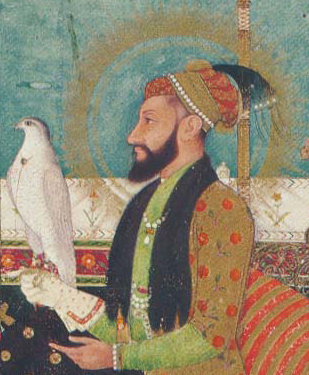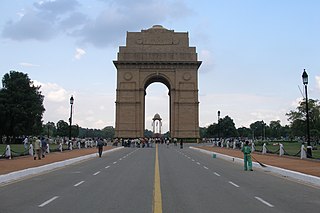
Muhi al-Din Muhammad, commonly known by the title Aurangzeb, and also by his regnal name Alamgir I, was the sixth Mughal emperor, reigning from 1658 until his death in 1707. Under his emperorship, Mughal Empire reached its greatest extent with territory spanning nearly the entirety of the Indian subcontinent.

Avul Pakir Jainulabdeen Abdul KalamBR was an Indian aerospace scientist and statesman who served as the 11th president of India from 2002 to 2007. Born and raised in a Muslim family in Rameswaram, Tamil Nadu, he studied physics and aerospace engineering. He spent the next four decades as a scientist and science administrator, mainly at the Defence Research and Development Organisation (DRDO) and Indian Space Research Organisation (ISRO) and was intimately involved in India's civilian space programme and military missile development efforts. He thus came to be known as the Missile Man of India for his work on the development of ballistic missile and launch vehicle technology. He also played a pivotal organisational, technical, and political role in India's Pokhran-II nuclear tests in 1998, the first since the original nuclear test by India in 1974.

Guru Har Krishan also known as Bal Guru, or Hari Krishan Sahib, was the eighth of the ten Sikh Gurus. At the age of five, he succeeded his father, Guru Har Rai, and became the youngest Guru in Sikhism. He contracted smallpox in 1664 and died before reaching his eighth birthday. It is said that he died because he contracted smallpox while successfully curing his followers.

Guru Tegh Bahadur was the ninth of ten gurus who founded the Sikh religion and was the leader of Sikhs from 1665 until his beheading in 1675. He was born in Amritsar, Punjab, India in 1621 and was the youngest son of Guru Hargobind, the sixth Sikh guru. Considered a principled and fearless warrior, he was a learned spiritual scholar and a poet whose 115 hymns are included in the Guru Granth Sahib, which is the main text of Sikhism.

Dara Shikoh, also transliterated as Dara Shukoh, was the eldest son and heir-apparent of the Mughal emperor Shah Jahan. Dara was designated with the title Padshahzada-i-Buzurg Martaba and was favoured as a successor by his father and his elder sister, Princess Jahanara Begum. He had been given the title of 'Shah-e-Buland Iqbal' by Shah Jahan. In the war of succession which ensued after Shah Jahan's illness in 1657, Dara was defeated by his younger brother Prince Muhiuddin. He was executed in 1659 on Aurangzeb's orders in a bitter struggle for the imperial throne.

Goindwal, also known as Goindwal Sahib and alternatively transliterated as Goindval, is located in the Taran Taran district of the Majha region of Punjab, India about 23 km (14 mi) from Tarn Taran Sahib. In the 16th century it became an important center for the Sikh religion during the Guruship of the Guru Amar Das Ji. Goindwal is on the banks of the Beas River and is one of the focal points of small scale industries of Tarn Taran district.

Gurdwara Sis Ganj Sahib is one of the nine historical Gurdwaras in Delhi. It was first constructed in 1783 as a small shrine by Baghel Singh to commemorate the martyrdom site of the ninth Sikh Guru, Tegh Bahadur and was probably expanded after Indian Rebellion of 1857 or after Partition of India. Before its construction the Mughal Kotwali was situated here. After the Indian Rebellion of 1857 the Mughal Kotwali was demolished by the British and the land was given to the Sikhs as the maharaja of Patiala and other Sikh soldiers helped the British to defeat the Mughal soldiers by providing large numbers of ammunition and soldiers. Its current building was made by Rai Bahadur Narain Singh a contractor who build most of roads in Lutyens New Delhi construction under British Rule. Situated in Chandni Chowk in Old Delhi, it marks the site where the ninth Sikh Guru was beheaded on the orders of the Mughal emperor Aurangzeb on 11 November 1675. The Sikh regiment of the Indian army salute the Sis Ganj Gurudwara before saluting the president of India since 1979, the only instance of saluting twice in the Republic Day parade by a regiment of Indian army.

10, Janpath is a public-owned house on Janpath, New Delhi. Currently, it serves as the residence of Sonia Gandhi, who has lived there since 1989, and her son Rahul Gandhi, who lived at 12, Tughlak Lane until April 2023.

Bhai Mati Das, along with his younger brother Bhai Sati Das were martyrs of early Sikh history. Bhai Mati Das, Bhai Dayala, and Bhai Sati Das were executed at a kotwali (police-station) in the Chandni Chowk area of Delhi, under the express orders of Emperor Aurangzeb just before the martyrdom of Guru Tegh Bahadur. Bhai Mati Das was executed by being bound between two pillars and cut in two.
Prithviraj Road is one of the historic & influential roads of New Delhi. It houses the most elite residences of major people of India.
Tughlaq Road is one of the main roads of Central New Delhi
Shahjahan Road is an important road of central New Delhi, India. It stretches from the India Gate junction on the north side and to the Taj Mansingh Hotel at the junction of Mansingh Road, Dr APJ Abdul Kalam Road, Humayun Road, Prithviraj Road and a road to Khan Market on the south. Also lined up on the Shahjahan Road are government houses for High Court Judges, Ministers and senior officials & bureaucrats in the Government of India.

Akbar Road is a main road, in central New Delhi, India. At the north-east end it stretches from the India Gate roundabout. At the south-west end it stretches up to the Teen Murti roundabout. The roundabout leads to Lok Kalyan Marg, Rajaji Marg, Teen Murti Marg and Safdarjung Road. It is also the road on which India's political party, Indian National Congress, has its head office.

Battle of Samugarh, Jang-e-Samugarh,, was a decisive battle in the struggle for the throne during the Mughal war of succession (1658–1659) between the sons of Mughal Emperor Shah Jahan after the emperor's serious illness in September 1657. The battle of Samugarh was the second battle fought between Dara Shikoh and his three younger brothers Aurangzeb, Shah Shuja and Murad Baksh to decide who would be the heir of the throne after their father.

Meenakshi Lekhi is an Indian politician who served as the Minister of State for External Affairs and Culture of India from 7 July 2021 till 10 June 2024. She was a Member of Parliament from New Delhi Parliamentary constituency in the 16th and 17th Lok Sabha from the Bharatiya Janata Party. She is also a lawyer in the Supreme Court of India.

Majma-ul-Bahrain is a Sufi text on comparative religion authored by Mughal Shahzada Dara Shukoh as a short treatise in Persian, c. 1655. It was devoted to a revelation of the mystical and pluralistic affinities between Sufic and Vedantic speculation. It was one of the earliest works to explore both the diversity of religions and a unity of Islam and Hinduism and other religions. Its Hindi version is called Samudra Sangam Grantha and an Urdu translation titled Nūr-i-Ain was lithographed in 1872.

Ram Rai was the excommunicated eldest son of the seventh Sikh Guru, Guru Har Rai, and the founder of the Ramraiyas, an unorthodox and heretical sect in Sikhism.

The Akal Sena was the Sikh military force established by the sixth Sikh Guru, Guru Hargobind. It was the first standing Sikh army. It was also known as the Akali Dal.
Dara Shikoh Road is the name given to a road in Central Delhi to honour mughal prince and heir apparent of Shah Jahan, Dara Shikoh. The road was earlier named after Lord Dalhouse. This road is located just 2 km from Rashtrapathi Bhavan.















